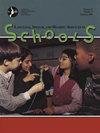Building Capacity for Bilingual Augmentative and Alternative Communication: Insights From Professional Learning Community Participants.
IF 2.9
3区 医学
Q1 AUDIOLOGY & SPEECH-LANGUAGE PATHOLOGY
Language Speech and Hearing Services in Schools
Pub Date : 2025-09-17
DOI:10.1044/2025_lshss-25-00044
引用次数: 0
Abstract
PURPOSE This study examines the perspectives of augmentative and alternative communication (AAC) professionals on the impact of participation in a professional learning community (PLC) focused on delivering AAC services to bilingual children. Specifically, it investigates the professionals' perceptions on (a) their professional development, (b) the learning environments in which they work, and (c) the families and children they serve. METHOD Over a period of 10 months, a PLC was formed with 15 AAC service providers who work with bilingual users of AAC in educational settings in the United States. Using an action research framework, the PLC engaged in iterative cycles of goal setting, action, observation, and reflection. Data were collected through recorded online PLC meetings and reflective questionnaires. Thematic analysis was used to analyze participants' perspectives on the impact of the PLC. RESULTS Participants described changes in their professional development, including increased focus on accountability, shifts in mindset, and confidence in advocating for bilingual AAC. Changes were also noted in learning environments, with reports of staff becoming more aware of bilingual AAC and incorporating it into classroom routines to different extents. Additionally, some families engaged more and with enthusiasm in AAC use. Participants observed instances of increased use of bilingual AAC among students, although the extent of home language incorporation varied. CONCLUSIONS The findings suggest that participation in a collaborative and reflective PLC can facilitate professional development, improved AAC service delivery, and increased family and student engagement in bilingual AAC. Although the study does not claim direct causation, participants perceived meaningful changes linked to their PLC involvement. Future research should explore the scalability of PLCs in AAC and their long-term impact on service provision and client outcomes.双语增强和替代沟通能力的建设:来自专业学习社区参与者的见解。
目的:本研究探讨了增强型和替代沟通(AAC)专业人士对参与专业学习社区(PLC)为双语儿童提供增强型和替代沟通服务的影响的看法。具体而言,它调查了专业人员对以下方面的看法:(a)他们的专业发展,(b)他们工作的学习环境,以及(c)他们所服务的家庭和儿童。方法在10个月的时间里,由15个AAC服务提供商组成了一个PLC,他们在美国的教育环境中为双语AAC用户提供服务。使用行动研究框架,PLC参与目标设定、行动、观察和反思的迭代循环。通过记录PLC在线会议和反思性问卷收集数据。专题分析用于分析参与者对PLC影响的看法。结果参与者描述了他们在专业发展方面的变化,包括更加关注问责制、思维方式的转变以及对倡导双语AAC的信心。学习环境也发生了变化,据报告,教师们越来越意识到双语AAC,并在不同程度上将其纳入课堂常规。此外,一些家庭对AAC的使用更加投入和热情。参与者观察到学生中使用双语AAC的情况有所增加,尽管使用母语的程度各不相同。研究结果表明,参与合作性和反思性的双语教学可以促进专业发展,改善双语教学服务的提供,增加家庭和学生对双语教学的参与。虽然这项研究并没有声称有直接的因果关系,但参与者感觉到与他们参与PLC有关的有意义的变化。未来的研究应探讨plc在AAC中的可扩展性及其对服务提供和客户结果的长期影响。
本文章由计算机程序翻译,如有差异,请以英文原文为准。
求助全文
约1分钟内获得全文
求助全文
来源期刊

Language Speech and Hearing Services in Schools
Social Sciences-Linguistics and Language
CiteScore
4.40
自引率
12.50%
发文量
165
期刊介绍:
Mission: LSHSS publishes peer-reviewed research and other scholarly articles pertaining to the practice of audiology and speech-language pathology in the schools, focusing on children and adolescents. The journal is an international outlet for clinical research and is designed to promote development and analysis of approaches concerning the delivery of services to the school-aged population. LSHSS seeks to advance evidence-based practice by disseminating the results of new studies as well as providing a forum for critical reviews and meta-analyses of previously published work.
Scope: The broad field of audiology and speech-language pathology as practiced in schools, including aural rehabilitation; augmentative and alternative communication; childhood apraxia of speech; classroom acoustics; cognitive impairment; craniofacial disorders; fluency disorders; hearing-assistive technology; language disorders; literacy disorders including reading, writing, and spelling; motor speech disorders; speech sound disorders; swallowing, dysphagia, and feeding disorders; voice disorders.
 求助内容:
求助内容: 应助结果提醒方式:
应助结果提醒方式:


